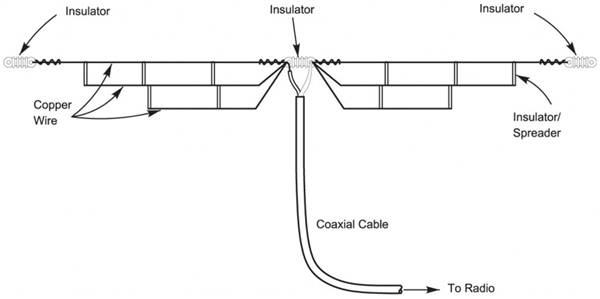|
This antenna consists of several dipoles joined at the center with a common feed point. Normally the dipoles are held apart by spacers at the ends. The operating theory of the performance of this type of antenna is that only one of the dipoles is resonant on any ham band and the other dipoles have minimal effect on the resonant one. To see the effect of putting dipoles in parallel with a common feed, I will start with a 40m dipole arranged in an inverted-V and then add smaller dipoles for other bands to see what effect they have on the radiation pattern and impedance of the dipole. All cases are modeled using Multi-NEC with the NEC-3 calculation engine. In all modeling cases #16 copper wire is used and the center of the antenna is 30 feet above ground with the 40m dipole ends 10 feet above ground. In all cases a real ground is used in the calculation. 40m Inverted V Adding a 30m Dipole Adding a 20m Dipole Summary It's interesting to compare the element lengths given by the modeling program at resonance. A common formula used to estimate the length of a dipole leg is L = 234/F, where L is in feet and F in MHz. The lengths given at resonance in this exercize turn out to be slightly different. for teh 40m element each leg is represented by 235.2/F, while both the 30m and 20m elements are 242.6/F at resonance. So what does this all mean in terms of building a parallel dipole? First, the way to build and trim such an antenna is indeed the method recommended by the old timers: Trim the longest one first, then the second longest, etc. The effects of interaction between the elements will not cause enough problems to worry about. Second, cut the elements a little longer than estimated from standard formula. It appears that, except for the longest dipole, the others need to be a few percent longer to resonate. This is probably due to additional capacitance caused by coupling to the other dipoles. Third, as for all types of dipoles, don't expect a low radiation angle unless you get the antenna significantly above ground (in terms of wave length). Also, since this is a balanced antenna, the use of a balun is recommended if you feed it with 50 ohm coax.
Alpha Delta DX-EE Four-band Dipole Antenna Field Guide to Simple HF Dipoles
Multiband Parallel Dipole Antenna
|
